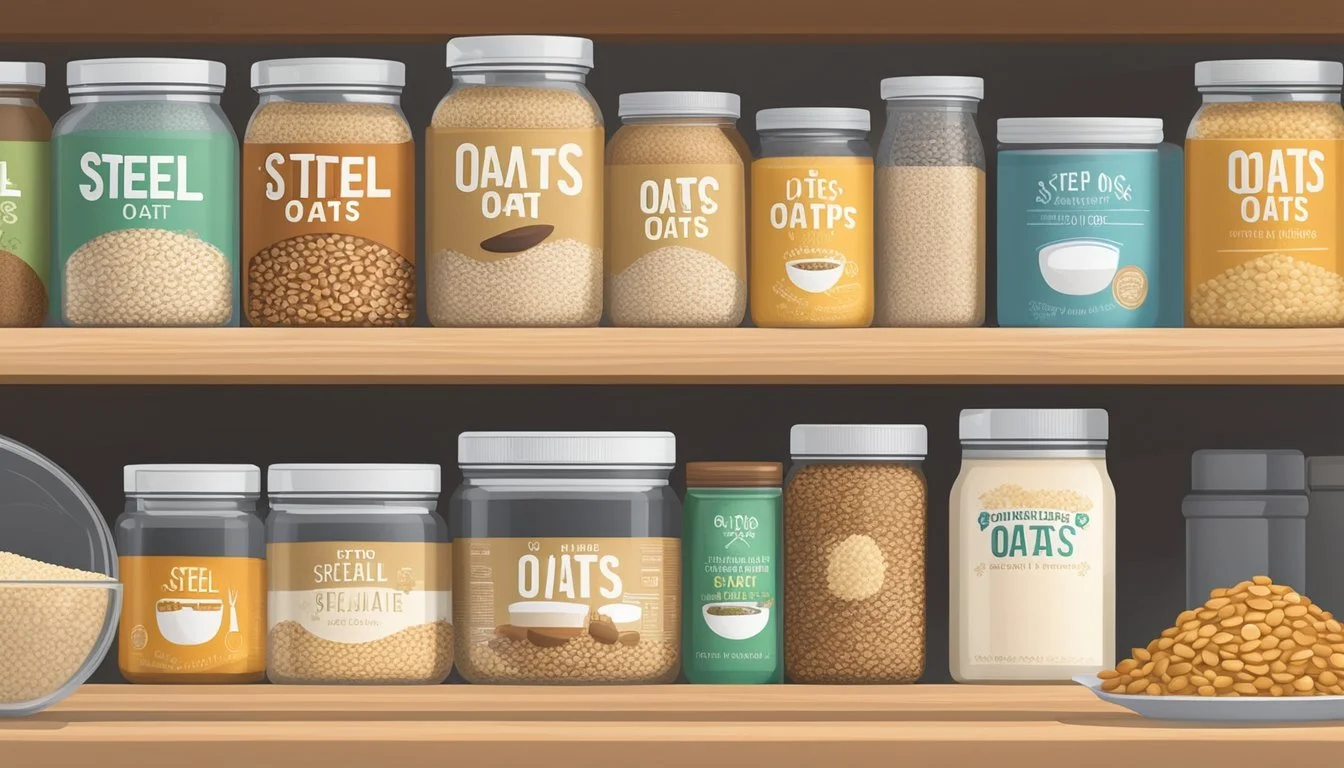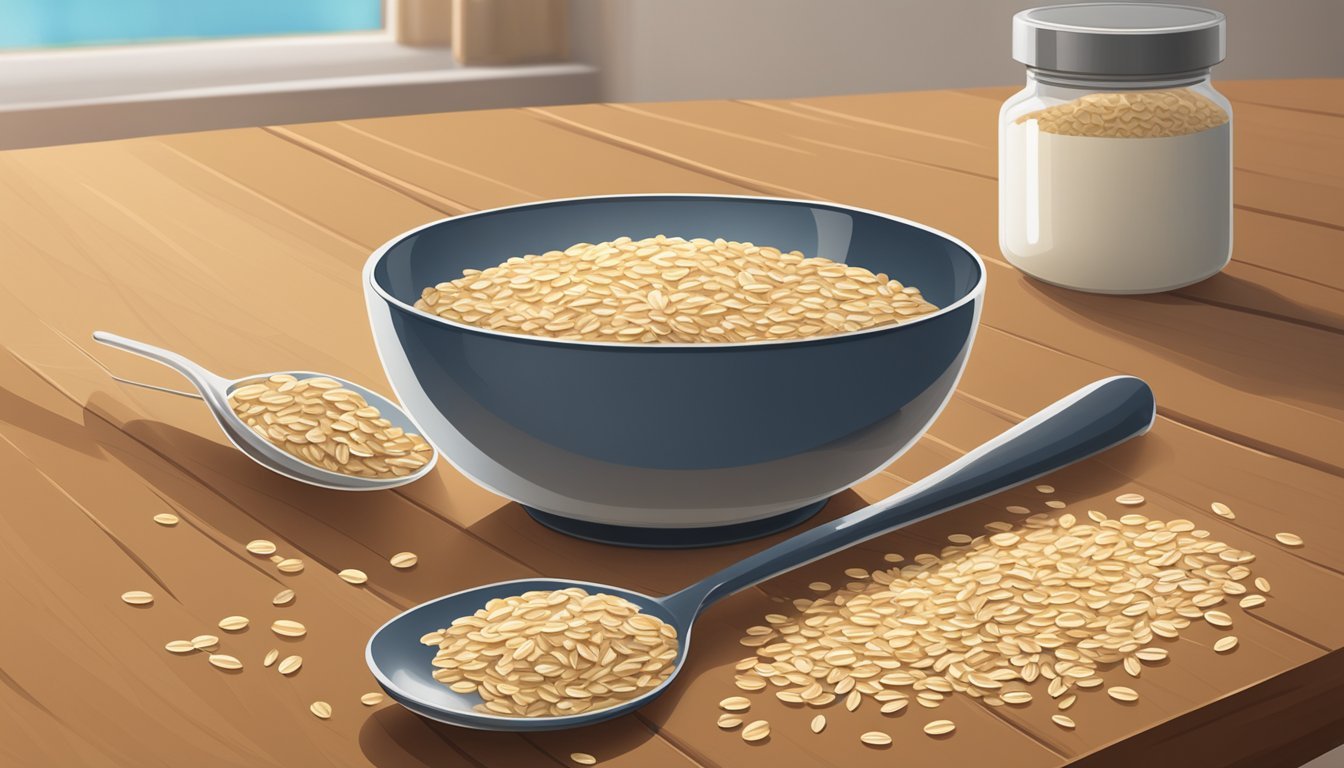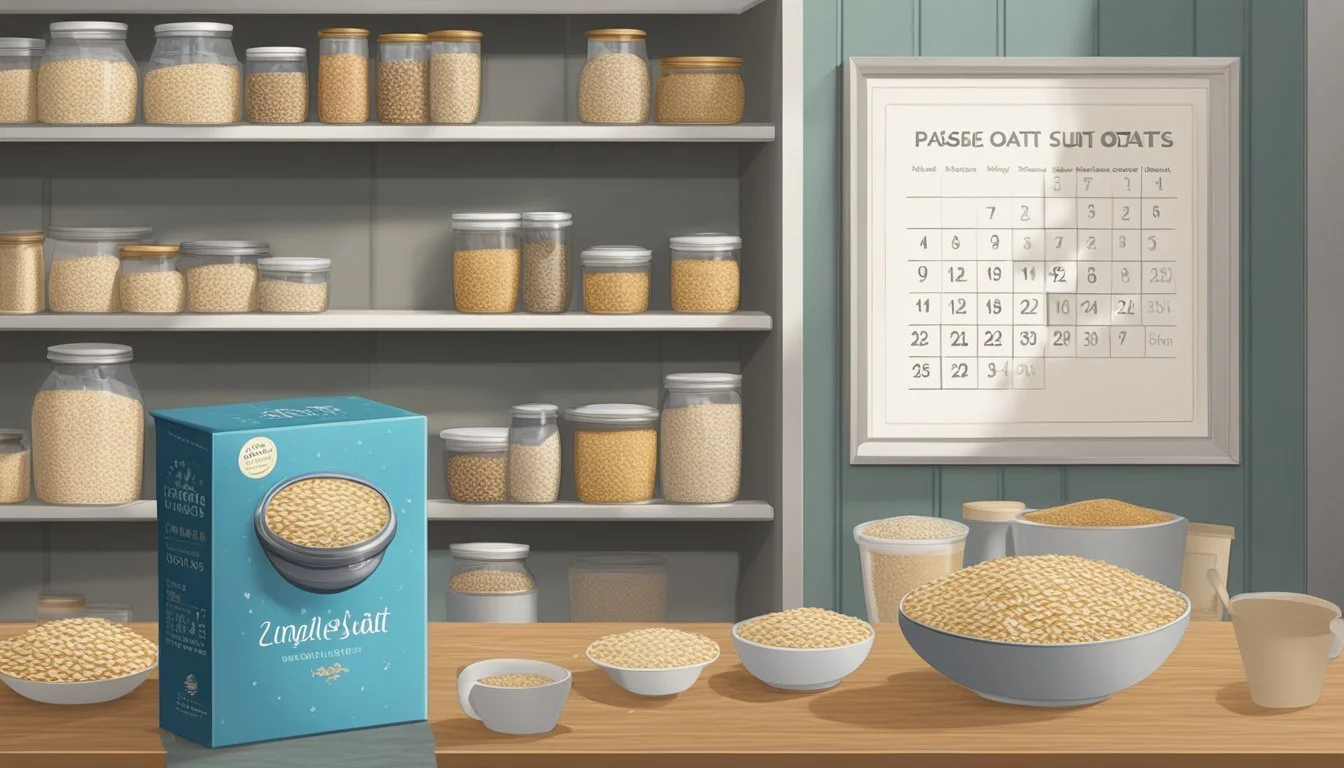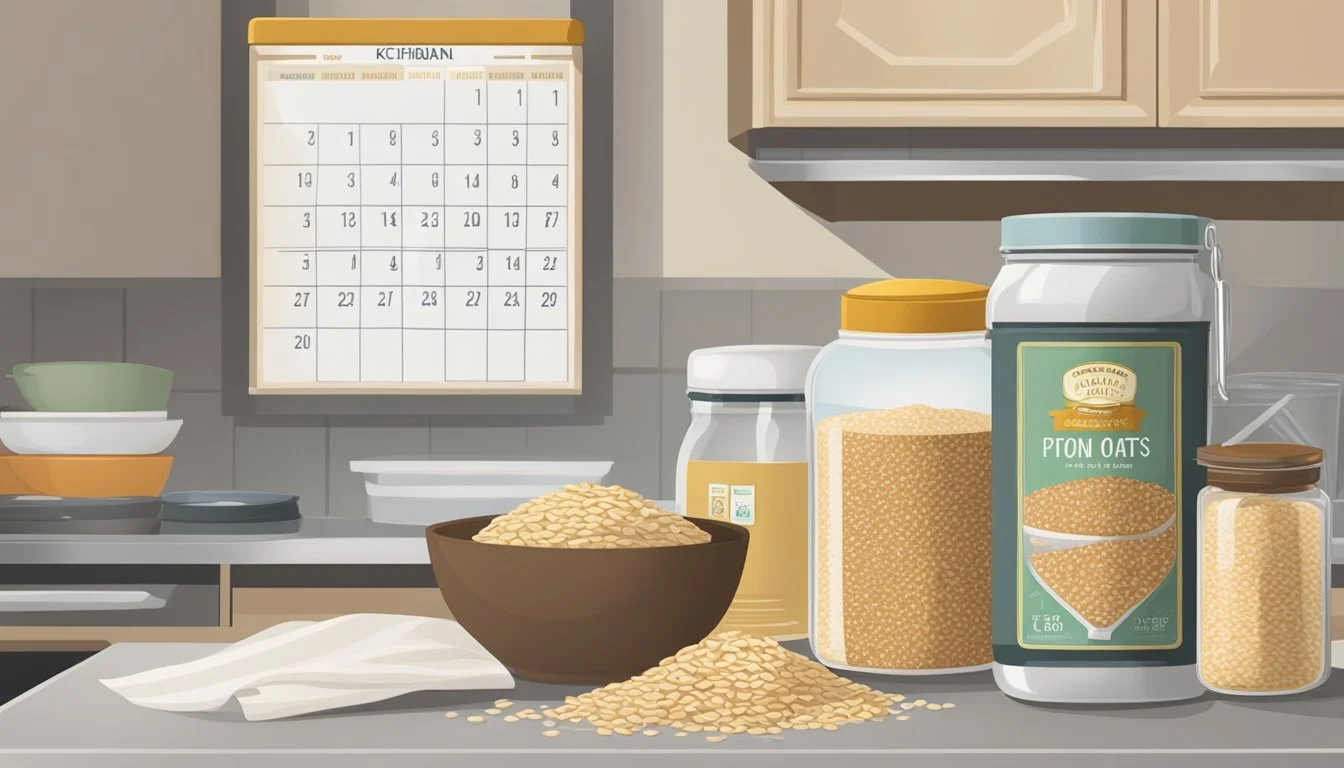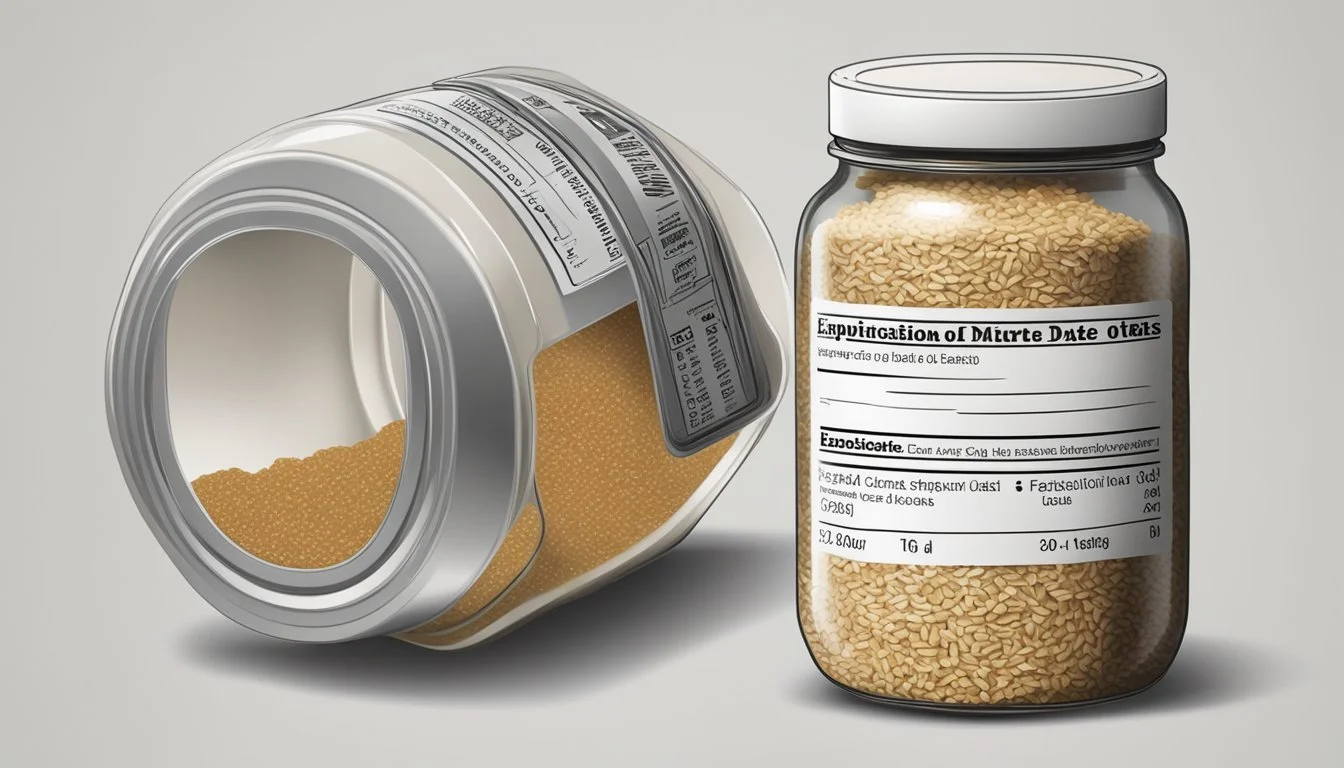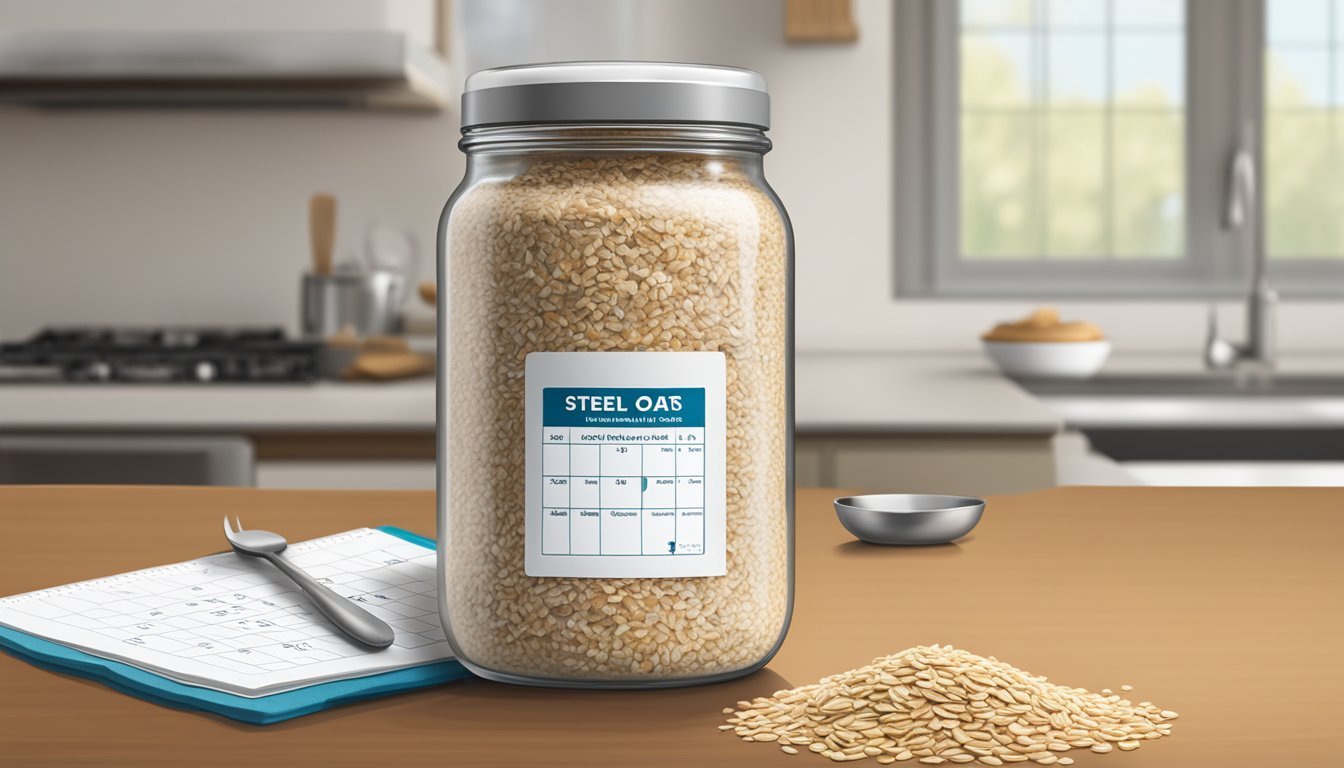How Long Do Steel-Cut Oats Last?
Shelf Life and Storage Tips
Steel-cut oats (how long do steel-cut oats last?) are a popular, hearty breakfast choice known for their nutritional benefits and extended shelf life. These oats are less processed than rolled or quick oats (how long do quick oats last?), which preserves more of the grain's fiber and nutrients. When stored properly, steel-cut oats can remain safe to eat for a considerable amount of time beyond their labeled expiration date. The longevity of steel-cut oats is a result of their minimal processing and the absence of added ingredients that can spoil quickly.
The typical shelf life for uncooked steel-cut oats, when kept in a cool, dry place, is at least 12 months, and with ideal storage conditions, it can extend up to two years if the package is unopened. Because steel-cut oats have a hard outer hull that protects the inner seed, they are less susceptible to moisture and rancidity compared to more processed oats. This durability contributes to their long shelf life and sustains their spot as a staple item in pantries.
Factors such as humidity, temperature, and exposure to air can affect the freshness and taste of steel-cut oats over time. Although they can last for years, it's crucial to store them correctly to maintain their quality. Containers that are airtight, impermeable to light, and kept away from any heat sources help preserve the integrity of the oats. Using steel-cut oats beyond the expiration date is generally safe provided they have been stored with care and show no signs of spoilage.
Understanding Steel-Cut Oats
Steel-cut oats are a hearty, nourishing grain known for their distinctive texture and nutritional benefits. They differ from other oat varieties not only in form but also in their cooking requirements and health contributions.
Differentiating Oat Types
Steel-cut oats are one form of whole oat groats (how long do oat groats last?)— the least processed form of oats. Groats are the hulled kernels of various cereal grains. After harvest, the inedible hull is removed from the raw oats, turning them into whole oat groats. Steel-cut oats result from these whole oat groats being chopped into two or three pieces with a steel blade, hence their name. They are sometimes referred to as Irish or Scottish oats.
Compared to other types of oats, such as rolled oats (how long do rolled oats last?) or instant oats, steel-cut oats retain more of their texture after cooking. Rolled oats, also known as old-fashioned oats, are steamed and then flattened with large rollers. This process leads to their flatter shape and quicker cooking time. They also tend to have a softer, more mushy texture when cooked. Instant oats are pre-cooked, dried, and then rolled even thinner than regular rolled oats, making them the quickest to prepare, with a texture that's quite soft and often less satisfying for those who prefer a chewier grain.
Oat Type Processing Texture When Cooked Steel-Cut Oats Chopped from whole oat groats with a steel blade Chewy and nutty Rolled Oats Steamed and flattened Soft and somewhat mushy Instant Oats Pre-cooked, dried, then rolled thin Very soft
Nutritional Profile of Steel-Cut Oats
Steel-cut oats are valued for their nutritional profile. They are a good source of fiber, both soluble and insoluble, which can aid in digestion and help maintain healthy cholesterol levels. The soluble fiber in oats is called beta-glucan, which has been linked to improving cholesterol levels and heart health.
In addition to fiber, steel-cut oats are packed with essential vitamins and minerals, including B vitamins, iron, and magnesium. They offer a robust supply of plant-based protein and have a low glycemic index, which may contribute to more stable blood sugar levels.
From a macronutrient perspective, steel-cut oats offer a balance, containing complex carbohydrates and a moderate amount of healthy fats. They are naturally free of cholesterol.
Here is a simplified nutritional breakdown for steel-cut oats:
Nutrient Benefit Fiber Digestive health, cholesterol management Protein Muscle repair, satiety Vitamins Metabolic and immune function Minerals Bone health, energy production Healthy Fats Heart health, nutrient absorption
Steel-cut oats provide a dense, chewy texture and rich, nutty flavor that distinguishes them from other processed oats and whole grains. They are a wholesome choice for anyone seeking a nutritious start to their day or a satisfying meal component.
Optimal Storage Solutions
To ensure the longevity and freshness of steel-cut oats, one must adhere to specific storage methodologies. These are paramount in warding off moisture, light, and oxygen – the primary agents of oxidation that can compromise quality.
Selecting the Right Containers
Materials and Design: The choice of storage container plays a critical role in preserving the quality of steel-cut oats. Ideally, containers should be made of glass, ceramic, or stainless steel. These materials are less permeable to oxygen, which helps to prevent oxidation. Containers must also be airtight to shield the oats from moisture and contaminants.
Glass containers: Translucent yet can be shielded from light.
Ceramic containers: Opaque and naturally protect from light.
Stainless steel containers: Sturdy and impervious to light, though not transparent.
List of Container Qualities:
Airtight seal: Essential to prevent moisture and pests.
Opaque or darkly tinted: If using glass, it should be stored away from light.
Ideal Storage Conditions
Environment: Preservation of steel-cut oats is not solely dependent on the containers used but also where and how these containers are stored. An environment that is consistently cool and dry is vital to prevent the degradation of the oats.
Cool, dry place: A pantry or cupboard away from appliances and heat sources.
Refrigerator: Suitable for extending freshness, especially in humid climates.
Freezer: An option for the longest-term storage, though not necessary for uncooked oats.
Checklist for Storage Conditions:
Avoid light: Store containers in a dark cupboard or pantry.
Maintain dryness: Prevent exposure to moisture to avoid mold growth.
Regulate temperature: Although steel-cut oats are robust, extreme temperatures can hasten spoilage. Keep them in a cool spot.
Shelf Life Details
Steel-cut oats are a healthy breakfast option known for their long shelf life. Proper storage is key to maintaining their quality and freshness.
Unopened Packaging
When unopened, steel-cut oats can typically last at least 12 months. Stored correctly, their shelf life can extend to up to 2 years while retaining quality. Factors like exposure to extreme temperatures and moisture can compromise this duration.
Opened Oats
Once opened, the oats' exposure to air and humidity can decrease their shelf life. It is advisable to transfer the oats to an airtight container to maintain freshness. They should remain in good condition for approximately 6 months after opening, though this can vary based on storage conditions.
Prepared Oatmeal
Cooked steel-cut oats have a much shorter shelf life and should be consumed within 4-5 days when stored in the refrigerator. Indicators of spoilage include an off smell, changes in color, or presence of mold. It's important to taste a small amount before consumption to ensure the oats haven't spoiled.
Preventing Spoilage
Storing steel-cut oats properly is essential to prevent spoilage and extend their shelf life. This section will cover the factors that can cause oatmeal to spoil and how to identify when oats are no longer suitable for consumption.
Factors Influencing Oatmeal Spoilage
Environmental Conditions:
Humidity: Oats can absorb moisture from the air, which promotes mold growth and spoilage. Steel-cut oats should be stored in a cool, dry place.
Temperature: High temperatures can accelerate spoilage. It’s best to store oats away from heat sources.
Storage Area: An airtight container in a pantry or cupboard is ideal. Avoid basements or garages where humidity levels are more difficult to control.
Handling and Storage Practices:
Containers: Use air-tight containers to protect oats from moisture and pests.
Cross-Contamination: Keep oats away from strong odors and contaminants that could affect their taste or safety.
Food Rotation: Practice first-in, first-out to use older oats first and reduce food waste.
Signs of Oats Spoilage
Mold Growth: If there is visible mold on the oats, they should not be consumed.
Unusual Smells: A sour or musty odor is a clear indication that oats have spoiled.
Texture Changes: Oats that clump together or have changed in texture may have absorbed excess moisture which can lead to foodborne illness.
By understanding these factors and signs, one can ensure the safety and quality of steel-cut oats, prolonging their shelf life, and minimizing food waste.
Extending Oatmeal's Shelf Life
To retain the freshness and nutritional quality of steel-cut oats for an extended period, one should employ proper storage techniques, such as airtight sealing and, if necessary, freezing.
Proper Sealing Techniques
Airtight containers are crucial for prolonging the shelf life of steel-cut oats. Transferring oats from their original packaging to a sealed container eliminates the risk of exposure to air and moisture, which can lead to the degradation of the oats. Containers made of glass or high-quality plastic with sealing gaskets offer robust protection against the elements. Using vacuum-sealed bags can further extend the oats' freshness by removing air from the package, thus diminishing the risk of oxidation and pest infiltration.
Freezing Options
Freezing steel-cut oats is a viable method for long-term storage. When opting to freeze oats, it's imperative to use freezer-safe containers or bags to prevent freezer burn, which can affect taste and texture. For optimal results, oats should be placed in air-tight containers or sealed bags, expelling as much air as possible before freezing. This method can significantly extend their shelf life beyond what's achievable through refrigeration alone. It's recommended to label the container with the freeze date to keep track of storage time.
Usage and Preparation
When it comes to steel-cut oats, their versatility in recipes and ease of reheating make them a convenient and nutritious option for meals.
Reheating Stored Steel-Cut Oats
To reheat stored steel-cut oats, place them in a microwave-safe bowl or a saucepan with a splash of milk or water. Reheating instructions include warming them gently in the microwave or on the stovetop. Stir the oats a few times throughout the heating process, and add additional liquid as needed to prevent drying out.
Microwave: Heat for 1-2 minutes, stir, and continue heating if needed.
Stovetop: Cook on low heat, stir frequently, and simmer till the desired temperature is reached.
Incorporating Oats into Recipes
Steel-cut oats are not only for porridge; they can be a substantial ingredient in various recipes. For savory dishes, one can add oats to stews or use them to make a pilaf. Sweet options include combining them with cream, dried fruits (What wine goes well with dried fruits?), nuts, or sweeteners to create flavored oatmeal packets at home without added preservatives. Moreover, they are excellent for making baked goods or overnight oats, offering a satisfying texture and added fiber. Cooks value the ability to adjust steel-cut oats' texture and flavor profile, from creamy and tender to chewy and nutty, depending on the amount of liquid used and cooking time.
Health Considerations
When considering the inclusion of steel-cut oats in a diet, it is important to weigh both their benefits and any potential health risks. They are often recognized for their nutritional value and potential to lower cholesterol levels due to their high fiber content.
Benefits of Including Steel-Cut Oats in Diet
Steel-cut oats are a nutritious and healthy breakfast option, especially for those following a vegan diet. They are rich in:
Soluble Fiber: Aids in lowering cholesterol levels and improving heart health.
Antioxidants: Help protect the body from oxidative stress.
Plant-based Protein: Provides essential amino acids for body function.
The fiber content in steel-cut oats not only helps to lower cholesterol but also contributes to a feeling of fullness, which can assist in weight management.
Risks and Considerations
While steel-cut oats are generally safe and healthy for most individuals, there are some considerations one should keep in mind:
Caloric Content: While nutritious, they are calorie-dense, and portion control should be exercised.
Gluten Concerns: Individuals with celiac disease or gluten sensitivity should ensure their oats are certified gluten-free due to potential cross-contamination in processing.
Cooking Time: Their longer cooking time may not suit everyone's lifestyle or meal preparation habits.
It's crucial to consume steel-cut oats as part of a balanced diet to fully enjoy their nutritional benefits.
Enhancing Taste and Texture
When preparing steel-cut oats, achieving the desired taste and texture is paramount. It involves selecting appropriate cooking methods and combining various ingredients for flavor enhancement and textural variety.
Ideal Cooking Methods
Steel-cut oats are known for their superior texture compared to quick-cooking oats. To fully bring out their creaminess and bite, gentle and slow cooking is essential. They should be simmered on the stovetop with a liquid, typically water or milk, for about 20-30 minutes. Adding a pinch of salt during cooking can enhance the natural flavor of the oats without overwhelming them.
Mixing with Other Ingredients
Incorporating added ingredients to steel-cut oats can transform them into a delightful meal. Fruit is a classic addition; for instance, one can stir in fresh berries or roasted apples depending on the season. Cream or milk can be added for extra richness, creating a more luxurious texture. For those who prefer sweeter oats without loads of sugar, natural sweeteners like dried fruit provide both sweetness and a chewy contrast. Here's a simple guideline to mixing in ingredients:
Creaminess: Add a dollop of cream or replace water with milk.
Flavor: For sweetness, mix in a spoonful of brown sugar or drizzle honey. To savor the oats' natural taste, sprinkle a pinch of salt.
Texture: Incorporate dried fruit or nuts for additional crunch and chewiness.
By experimenting with these elements, cooks can create a myriad of flavored oatmeal dishes without relying on pre-packaged flavored oatmeal packets.
Dealing with Leftovers
When managing leftovers of steel-cut oats, one should ensure proper storage to maintain freshness and find creative uses to minimize food waste. Here's how one can extend the life of cooked oatmeal and turn it into a new dish.
Storage Tips for Leftover Oatmeal
Leftover steel-cut oats should be refrigerated within two hours of cooking to preserve their quality. The ideal storage method is:
Temperature: Keep it in the refrigerator at a temperature below 40°F (4°C).
Container: Use an airtight container to prevent moisture and other contaminants.
Duration: It is safe to store for up to five days.
Reheating: When reheating, add a splash of liquid (milk or water) to achieve the desired consistency.
For longer preservation, one can freeze the oatmeal using these steps:
Allow the oatmeal to cool completely.
Portion the oatmeal into individual servings.
Store in freezer-safe bags or containers.
Label with the date. Cooked oatmeal can last in the freezer for up to 3 months.
Creative Ideas for Using Leftover Oats
Instead of disposing of excess cooked oats, one can recycle them into creative recipes to maximize their use:
Savory Options:
Oatmeal Patties: Form the chilled oatmeal into patties and pan-fry until crisp.
Oat-Based Stuffing: Use the oatmeal as a base for a stuffing recipe, adding herbs and vegetables for flavor.
Sweet Alternatives:
Baked Treats: Incorporate oatmeal into baked goods such as muffins or bread for added texture.
Oatmeal Breakfast Bars: Mix with nuts, dried fruits, and honey, then bake until set for a quick snack.
By adhering to these storage tips and using cooked oatmeal in innovative recipes, food waste can be significantly reduced, and one can enjoy delicious dishes while saving money.
Misconceptions and FAQs
In the realm of pantry staples, steel-cut oats hold a reputation for long-term storage. However, incorrect information can lead to improper use or unnecessary waste. This section aims to address common misunderstandings and answer prevalent questions about steel-cut oats.
Clearing Common Misconceptions
Steel-Cut Oats are Indestructible: While steel-cut oats are a hearty type of oats, they are not impervious to spoilage. Best by dates are indicative guidelines; properly stored oats may last beyond this timeframe, but they can still deteriorate in quality and safety.
All Oat Types Have the Same Shelf Life: There is a variation in longevity among different oat types. Instant oatmeal and quick oats, being more processed, typically have a shorter shelf life compared to steel-cut and rolled oats.
Frequently Asked Questions
How long do steel-cut oats last? Steel-cut oats, when stored correctly, can last well beyond their "best by" date. An unopened package can last for 1 to 2 years. If stored in an airtight container in a cool, dry place, they may last even longer.
Can you eat steel-cut oats past the 'best by' date? Yes, steel-cut oats can be consumed past their 'best by' date if they have been stored properly and show no signs of spoilage.
What signs indicate that steel-cut oats have gone bad? Watch for changes in color, smell and texture. If oats develop an off smell, taste, or appearance, or if there is any sign of mold or pests, they should be discarded.
Does the way you store steel-cut oats affect their shelf life? Absolutely. Store them in an airtight container, in a cool, dry, dark place to extend their shelf life. Exposure to moisture, heat, and light can all significantly reduce the quality and safety of the oats.
Is there a difference in shelf life between commercially processed oats and organic steel-cut oats? Commercially processed oats, like instant oatmeal, often have preservatives that give them a longer shelf life. Organic steel-cut oats may lack these preservatives but can still last a long time if stored properly.
Using this knowledge, consumers can maintain the quality of steel-cut oats as a valuable pantry staple and enjoy their benefits long term.
Purchasing Strategies
When shopping for steel-cut oats, consumers should focus on the quality of the grains and consider purchasing strategies that cater to long-term storage. Proper selection and storage practices are crucial for maintaining the integrity and longevity of the oats.
Selecting High-Quality Oats
One should look for steel-cut oats that are uniformly sized and free from any signs of moisture, which can lead to mold. Opting for commercially processed packages ensures a standardized level of quality and often a longer shelf-life due to the sealed packaging that protects the oats from contaminants and pests.
Buying and Storing in Bulk
Purchasing steel-cut oats in bulk can be economical and convenient for long-term storage, though one should take precautions to ensure freshness:
Divide the bulk purchase into smaller, manageable portions that will be consumed in a timely manner.
Store these portions in airtight containers to protect against moisture and oxidation.
Keep the containers in a cool, dry place away from direct sunlight and strong odors.
Innovative Oatmeal Variations
As consumers seek out more diverse and flavorful breakfast options, the traditional oatmeal has undergone a transformation. Here, we explore the innovative ways to enjoy steel-cut oats through flavored combinations and creative meal ideas.
Exploring Flavored Oatmeal Options
One can elevate the taste of steel-cut oatmeal significantly by incorporating flavored oatmeal packets or adding natural ingredients to create a unique blend. Flavored oatmeal packets offer convenience and a variety of tastes ranging from fruity to spicy. However, creating homemade flavored oats allows for control over the ingredients, catering to those who may seek healthier breakfast options or have dietary restrictions.
Examples of homemade flavored oatmeal combinations include:
Apple cinnamon with a dash of nutmeg
Chocolate and peanut butter with a sprinkle of sea salt (how long does sea salt last?)
Pumpkin spice with a dollop of vanilla yogurt
These flavors not only add excitement to the morning routine but can also effortlessly transform oatmeal into a more creamy and indulgent experience.
Creative Breakfast Ideas
Steel-cut oats provide a versatile base for creative breakfast ideas. They can absorb a range of flavors and can be prepared in various styles, from overnight oats to a savory bowl topped with an egg.
For a quick and nutritious start, one might consider:
Overnight oats: Mix steel-cut oats with almond milk and chia seeds, then allow them to soak overnight. In the morning, one can add fresh berries and a drizzle of honey for a satisfying and easy breakfast.
Savory oatmeal: For those who prefer a less sweet breakfast, incorporating sautéed vegetables and a poached egg into a bowl of oatmeal can provide a hearty and savory start to the day.
Steel-cut oats also offer an excellent base for a vegan diet, as they can be easily combined with plant-based milks and toppings like nuts, seeds, and fruits. This approach to a classic dish not only aligns with dietary needs but also adds nutritional value and variety to the morning meal.
Environmental Impact
The environmental impact of steel-cut oats involves considerations about food waste and packaging. Both factors have significant effects on sustainability, and thoughtful practices in these areas can reduce the ecological footprint associated with oatmeal consumption.
Reducing Oatmeal-Related Food Waste
Food waste is a critical environmental issue, and preventing oatmeal waste is essential for both personal savings and ecological health. Consumers can extend the shelf life of steel-cut oats by storing them in airtight containers in a cool, dry environment. By doing so, oats can remain safe to consume far beyond their "best by" dates, often for up to two years, reducing the frequency of waste. Additionally, understanding that "best by" dates are indicators of quality, not safety, can help prevent premature disposal of oats that are still edible.
Sustainable Oatmeal Packaging Options
The packaging of steel-cut oats significantly influences their environmental impact. Choosing oats that come in recyclable or compostable containers can help minimize the product's carbon footprint. Brands that prioritize sustainability may use packaging made from recycled materials, which consumers can either repurpose or recycle. Such practices not only lessen the waste going to landfills but also reduce the demand for virgin materials used in packaging production, further conserving resources and energy.
Advanced Cooking Techniques
Employing advanced cooking techniques when preparing steel-cut oats can elevate a simple bowl of oatmeal into a more nuanced and enjoyable dish. These methods focus on refining texture and flavor while maintaining the nutritional integrity of the oats.
Mastering the Art of Oatmeal Preparation
The key to perfect oatmeal lies in the balance between texture and consistency.
Ratio: A standard recipe calls for a 1:3 or 1:4 ratio of steel-cut oats to water, depending on the desired thickness.
Simmering: It’s crucial to simmer the oats gently; a fierce boil can lead to a gluey texture.
Stirring: Regular stirring distributes heat evenly and prevents sticking, contributing to a creamier consistency.
One may also experiment with a soak-and-simmer technique, where the oats are first soaked overnight to reduce cooking time and enhance digestibility.
Special Tips from the Experts
Experts suggest several tips to ensure a superior oatmeal experience:
Steaming: After cooking, let the oats steam covered for a few minutes; this helps achieve a uniform texture.
Toasting: For a deeper flavor, toast the oats in a dry pan before adding water.
Layering Flavors: Introduce layers of flavor by cooking oats with a pinch of salt and adding aromatics such as cinnamon or vanilla.
Incorporating these steps into your cooking routine will result in a robust and delicious bowl of steel-cut oats.
Conclusion
Steel-cut oats offer a nutritious option for a healthy breakfast due to their minimal processing and high fiber content. When considering shelf life, steel-cut oats have a significant advantage. In their dry, uncooked form, they typically remain safe to consume for 1 to 2 years if stored correctly in a cool, dry place. Beyond this period, they may lose quality in terms of flavor and texture, although they are often still safe to eat.
It's vital for consumers to store steel-cut oats in airtight containers to maximize their longevity. This method prevents moisture and pests, which are the primary causes of spoilage. For those who prioritize food safety and quality, it's advisable to consume steel-cut oats within 6 to 12 months of purchase.
If oats have passed their expiration date on the package, it doesn't necessarily indicate they're unsafe. However, consumers should inspect the oats for any signs of spoilage such as an off smell or presence of mold. If any such signs are evident, the oats should be discarded.
In summary, while steel-cut oats indeed have a commendable shelf life, their quality is best when enjoyed closer to the purchase date. Proper storage and regular checks for spoilage can help ensure that consumers enjoy their oats in the safest and most delicious state possible.

